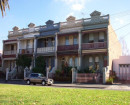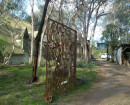POUND HILL
WHYTES ROAD SMYTHES CREEK, BALLARAT CITY
-
Add to tour
You must log in to do that.
-
Share
-
Shortlist place
You must log in to do that.
- Download report
Statement of Significance
This record has minimal details. Please look to the right-hand-side bar for any further details about this record.
-
-
POUND HILL - History
Contextual History:History of Place:
Heritage Inventory History of Site:
STANTON & DICKMAN, Pound Hill at Smythesdale
16.01.1904: mining on Pound Hill.
Pound Hill, Smythesdale
11.02.1905: shaft down 60 feet where the water is too difficult to deal with using a windlass.
04.03.1905: the Standard battery at Linton commenced crushing for the Pound Hill Co.
20.04.1905: a mine has been floated by Mr. Meudell and Mr. McKay of Melbourne; the float seems assured with 3000 to 4000 shares already applied for locally.
POUND HILL CO., Smythesdale
20.04.1905: the quarterly report for the Smythesdale Mining Division gives the yield for this company as 15 dwt 2 gr per ton from 90 tons crushed during the quarter.
27.05.1905: the company floated by Mr. Meudell and Mr. McKay is proposing to erect a battery and winding plant.
22.07.1905: shaft should be down to 200 feet for opening out in a few weeks; a start has been made on erecting the winding plant and a whip is being used at present.
09.09.1905: good progress in sinking the shaft to the 200 foot level and the company is proceeding to erect a 10 head battery.
04.11.1905: battery horses and wiper shaft are in position.
16.12.1905: battery delayed by the water giving out and a pump has been erected at the creek.
03.03.1906: temporarily suspended operations; the mine may be let on tribute.
31.03.1906: plant sold, both winding and crushing; mine may be given another trial.
28.09.1907: the Cherry Hill Co. has purchased the battery from the Pound Hill mine, which had previously been at the Homeward Bound mine; the plant will be removed and re-erected at a cost of £273 by Mr. Kinsman.
12.05.1906: despite the report of a new trial by a local syndicate this mine was wound up.
28.09.1907: the Cherry Hill Co. at Linton purchased the battery from the Pound Hill mine, which had previously been at the Homeward Bound mine; the plant will be removed and re-erected at Linton at a cost of £273 by Mr. Kinsman.
1904 to 1906: recorded production of 306 ozs 17 dwt from 989 tons (or 9.544 kg from 1,004 tonnes).
Information about the origin of the features at Pound Hill has been provided by Ray Willis whose great uncle lived in a house at Pound Hill. His great uncle was a fossicker who mined the shallow alluvial deposits along the rivers and creeks in the Smythesdale area. He, like many other men in the district at that time, cut firewood, trapped rabbits and went harvesting in season.Ray has known this area since he was a boy. He rescued the top pulley from the rotting whip pole over the 1930’s mine shaft and donated it to Sovereign Hill in the late 1970’s.Neither of the quartz reef mines was successful according to information passed onto Ray by his uncle.Heritage Inventory Description
POUND HILL - Heritage Inventory Description
200m south west of the track that comes off Whites Road there is a mound of gravel on the bank of the river. There are four levelled house sites identified by concentrations of bricks, other building materials and introduced trees on the flats near the river. 100 to 150 m further south west and 100 m away from the river there are two parallel trenches 5 m wide 3 m deep and 50 m long which run north east away from the river. 30m south west of the top of these trenches is the larger of the two quartz reef mines on Pound Hill. An 8 m diameter depression marks the location of the shaft. The four fingers of the mullock heap run in an arc of 65 degrees beginning in the north and swinging around to east north-east. The fingers are between 20 and 30 m long and approximately 5 m wide. They vary in height from 2.5 to 3.5 m. The most southerly finger has an additional length of 12 m running north. The mullock heap is covered with gorse. An area 28 m by 6 m has been levelled on the west side of the shaft, but there are no signs of machinery foundations on this benched area. 30 m south east of the first and larger quartz reef mine is the 1930?s quartz reef mine; an open shaft surrounded by a mullock heap 5 to 10 m in diameter and 1.5 m high. Next to this shaft is a circular platform around which a horse used to walk to operate the whip that was used at this mine. The platform is 8 m in diameter and 1 m high. It has a hole at its centre 1.2 by 0.25 m by 0.3 m deep. There is a single blot protruding from this hole. A trench runs north from the centre of the platform to two timber bearers on which a winch used to be mounted. The winch cable used to run over the pulley that was suspended on the whip pole over the shaft. The timbers on which the winch sat are 0.1 m thick and 1.8 m long and the width across the timbers is 1.3 m. This type of whip is an unusual feature, which has not yet been found elsewhere. 20 m south of the platform is the dam that provided water for the mine. It is 15 m by 6 m. The site of Ray Willis? great uncle?s house is just below the dam. A collapsed adit is located a further 50 m south of the house site.
Heritage Inventory Significance: Regional
-
-
-
-
-
SMYTHESDALE COURT HOUSE
 Victorian Heritage Register H1653
Victorian Heritage Register H1653 -
ROXBURGH CO.
 Victorian Heritage Inventory
Victorian Heritage Inventory -
YELLOW GLEN MINE
 Victorian Heritage Inventory
Victorian Heritage Inventory
-
-







